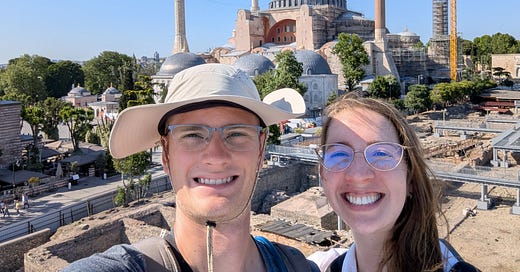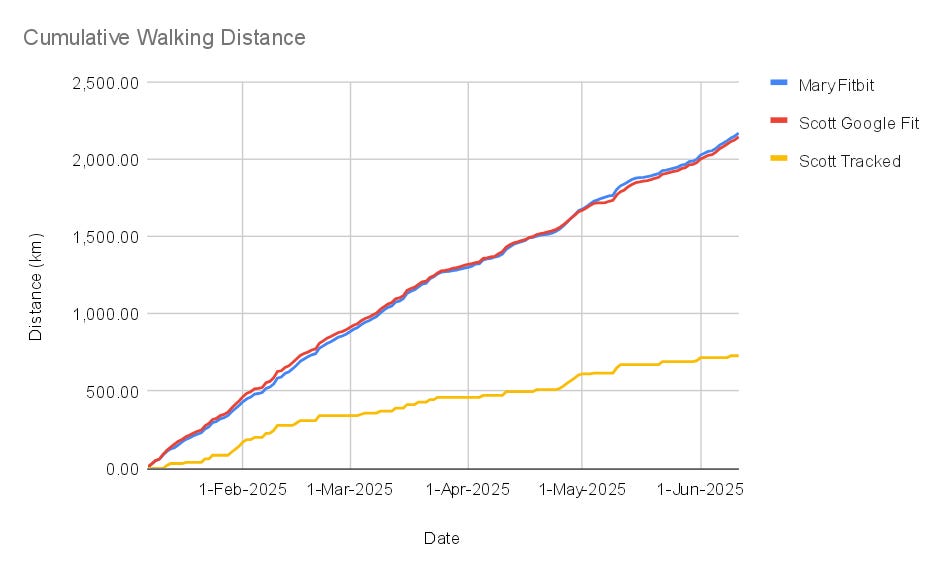This week brought us to Turkey's historic megacity - Istanbul. With over 15 million residents, the city straddles the Bosphorus which defines the border between Europe and Asia. The city's long history has been shaped by the Byzantine empire, the Ottoman Empire, and most recently the modern Turkish Republic. We got a brief taste for this bustling city as well as some of its quieter places during our stay.
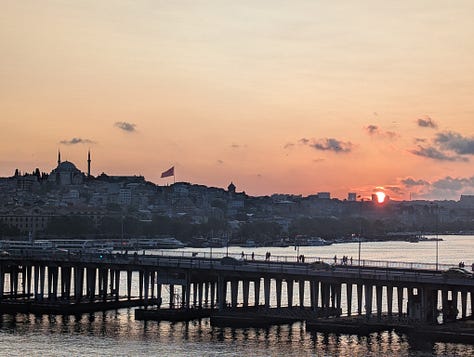
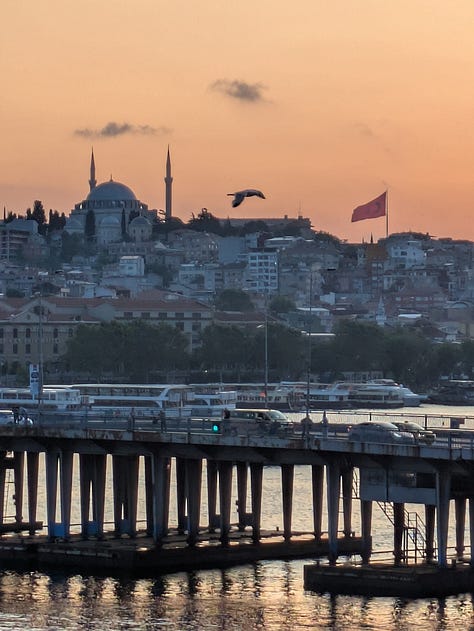
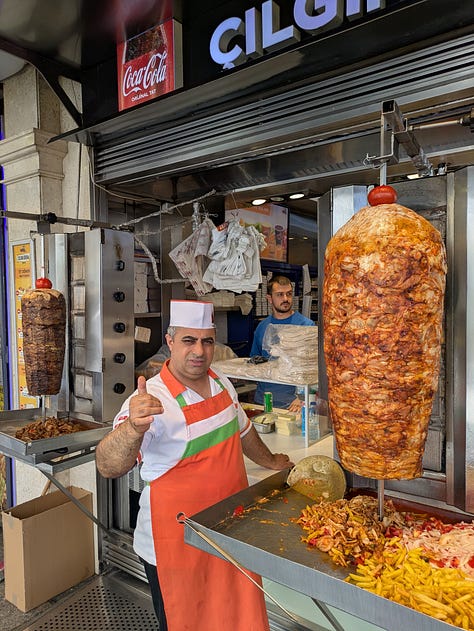
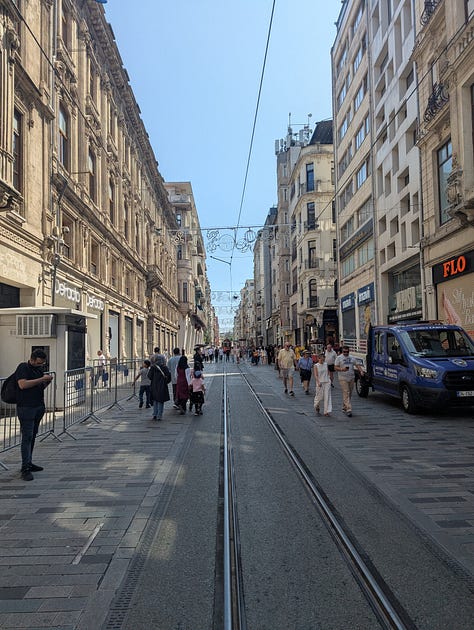
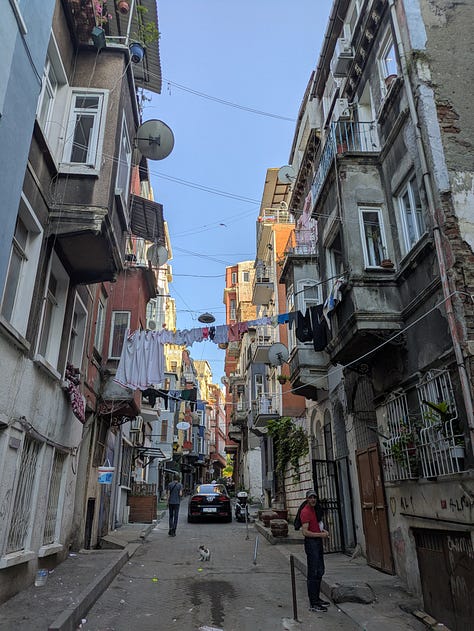
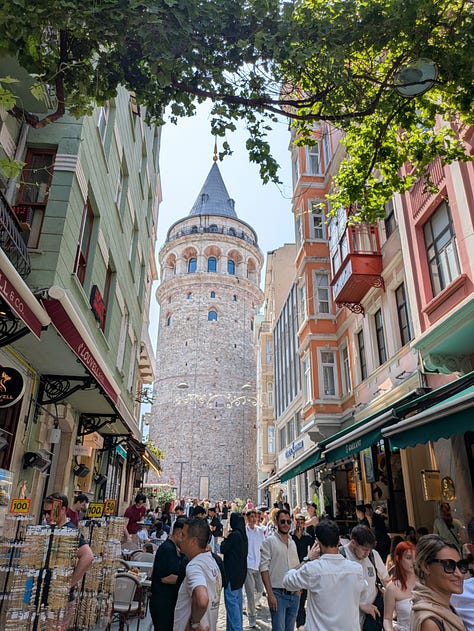
A Train to Istanbul
In our last update, we left off on route to the train station in Sofia. We'd purchased tickets for the Sofia Express night train to Istanbul and our evening departure was approaching. After making our way to the communist era station and collecting our bags (from the storage kiosk, as we had spent the day in the bathhouse), we made our way to to the platform. The departures board said our train would leave from platform 5 east, but at platform level information was sparse. A train was at the platform so we started walking along it in hopes of finding route information on the train itself or some of the train crew to ask.
We bumped into an Australian guy on the platform who was equally unsure whether or not he was in the right place and seemed glad to have found people looking for the same train as him. As we reached the end of the platform, the last three cars showed Istanbul as their destination and the train crew was outside, waiting to check our tickets. The Australian was in the same car as us; since we'd brought a bottle of wine along and there wasn’t much point in sleeping before our late night border crossing, we invited him to join us. We had a pleasant, wide ranging chat and (although we didn't catch the Aussie's name) learned he had been visiting some distant Greek relatives before doing some solo travel through the Balkans and Turkey.
Our train car was relatively spacious with sleeping bunks which folded up to reveal arm chairs, a mini fridge and a sink. It would have been a comfortable journey if not for the misfortune of non-functional air conditioning in our car. The result was a rather sweaty evening - a display panel showed an internal temperature of 32°C!
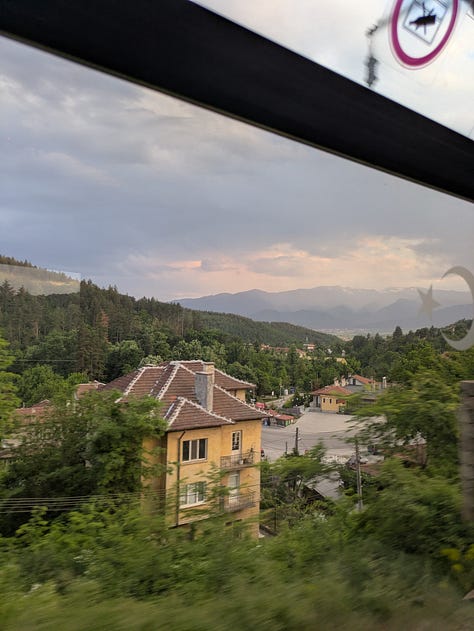
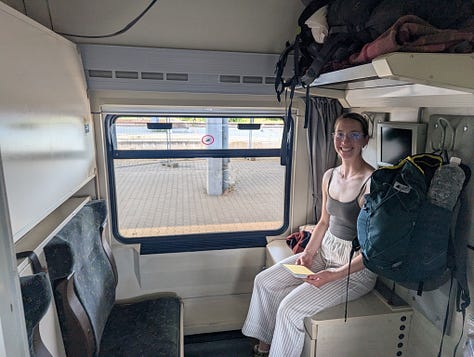

Shortly after midnight, we reached the Bulgarian border. A guard came onto the train to collect passports (and required Scott to wake a sleeping Mary to make sure she matched the passport photo) and departed with a stack to apply the required stamps. A few minutes later the passports returned and we were off to Turkey. Around 1:30am, we arrived at the Turkish border control station. Here we had to exit the train - along with all our baggage - while the train was checked by border officials. Passengers filed to a passport window to receive their Turkish entry stamps before being directed to a shack containing a x-ray machine for baggage. A few minutes after baggage checks, we were given the all clear to get back on the train - although it wasn't scheduled to depart for a couple more hours and the inside of our car was still rather warm.
As the night continued and we started moving, temperatures dropped to a more comfortable level. We heard the call to prayer while passing through some town around 5 am - it sounded more loud and lively than we've heard elsewhere, some combination of beautiful and jarring as it woke us from our light sleep aboard the train. Sunrise brought our first glimpses of Turkey showing a vast open landscape full of fields and lots of newish developments and apartment blocks in more urban areas.
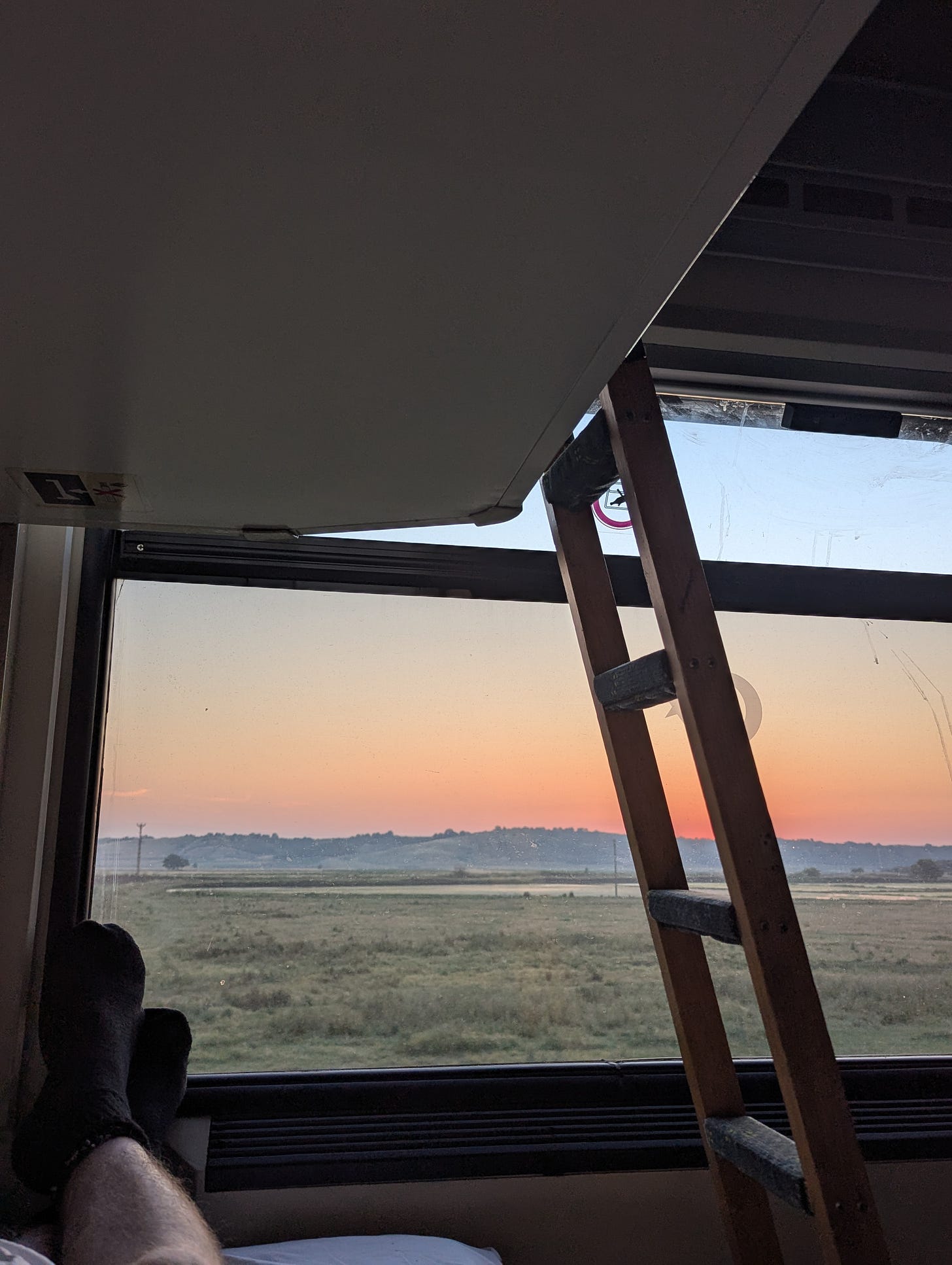
Around 10:30am, we arrived at the suburban Istanbul Halkali station which left us with an hour and a half transit journey to our accomodation in the centre of Taksim. Our accomodation had agreed to let us drop of bags ahead of a 2pm check-in, but conveniently let us check in early when we arrived. After our sweaty night on a hot train, early check-in and a nice shower were a pleasant welcome into Istanbul and the 18th country of the trip.
5-Jun-2025: A Walking Tour Introduction to Istanbul
After a refreshing shower in our room we set out into the heat for our 3pm free walking tour. We wandered down through busy and touristy Taksim and across Galaty bridge with dozens of men fishing over the side and spectacular views towards the historic centre of Istanbul. Various mosques dotted the city’s hilltops and to the east the Asian side of Istanbul was in view across the Bosphorus strait. Dozens of seagulls circled above our heads and the noise and bustle of the busy city surrounded us as we wove our way through the dense crowds. We wound through more of the beautiful city and found an oasis of cool shade from the heat in Gulhane park before continuing to the German fountain - a landmark in the the square where the Byzantine hippodrome once stood and the Blue Mosque and Hagia Sofia tower.
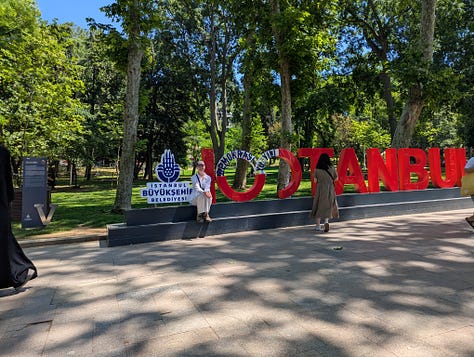
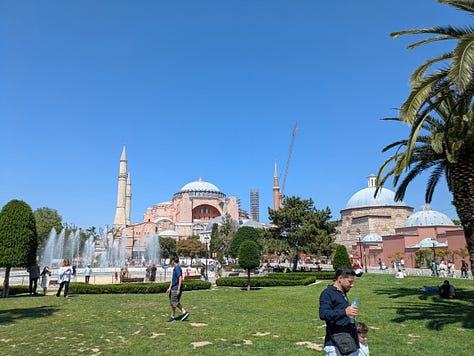
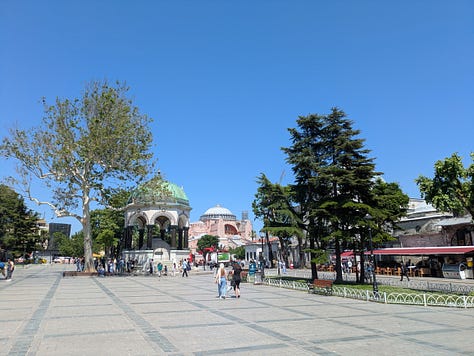
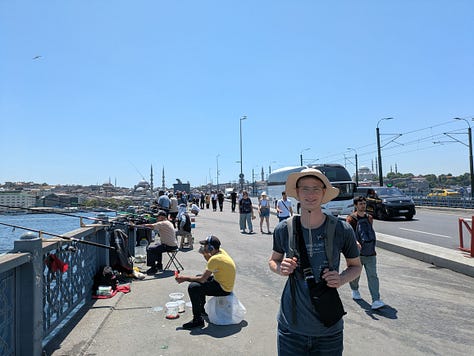
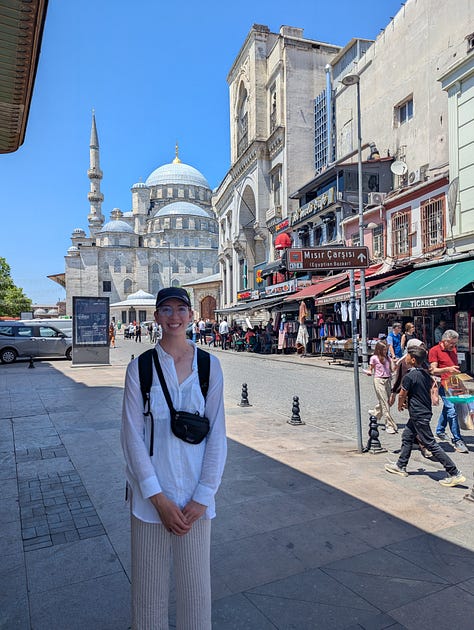
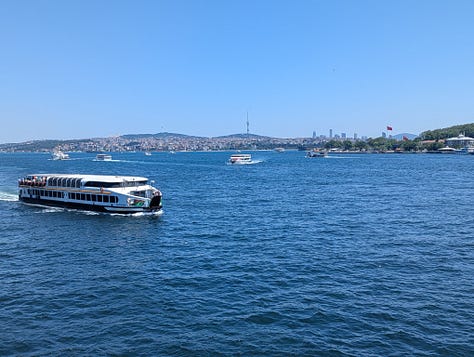
Our tour group was rather large (we even got headsets to better hear our guide) and our guide was a funny guy, with a few jokes at the expense of tourists as well as Turkish people. Our tour focused on the square and nearby attractions. Our guide pointed out the Egyptian obelisk transported from Alexandria to the hippodrome by the Byzantines - some of which was missing due to a breakage in transport and was replaced by a marble base explaining how the obelisk came to be in Constantinople. A bit further down the square was a masonry obelisk erected by the Romans while waiting for the Egyptian version; this was once covered with polished bronze plates, but marauding crusaders stole them and melted them down during the fourth crusade.
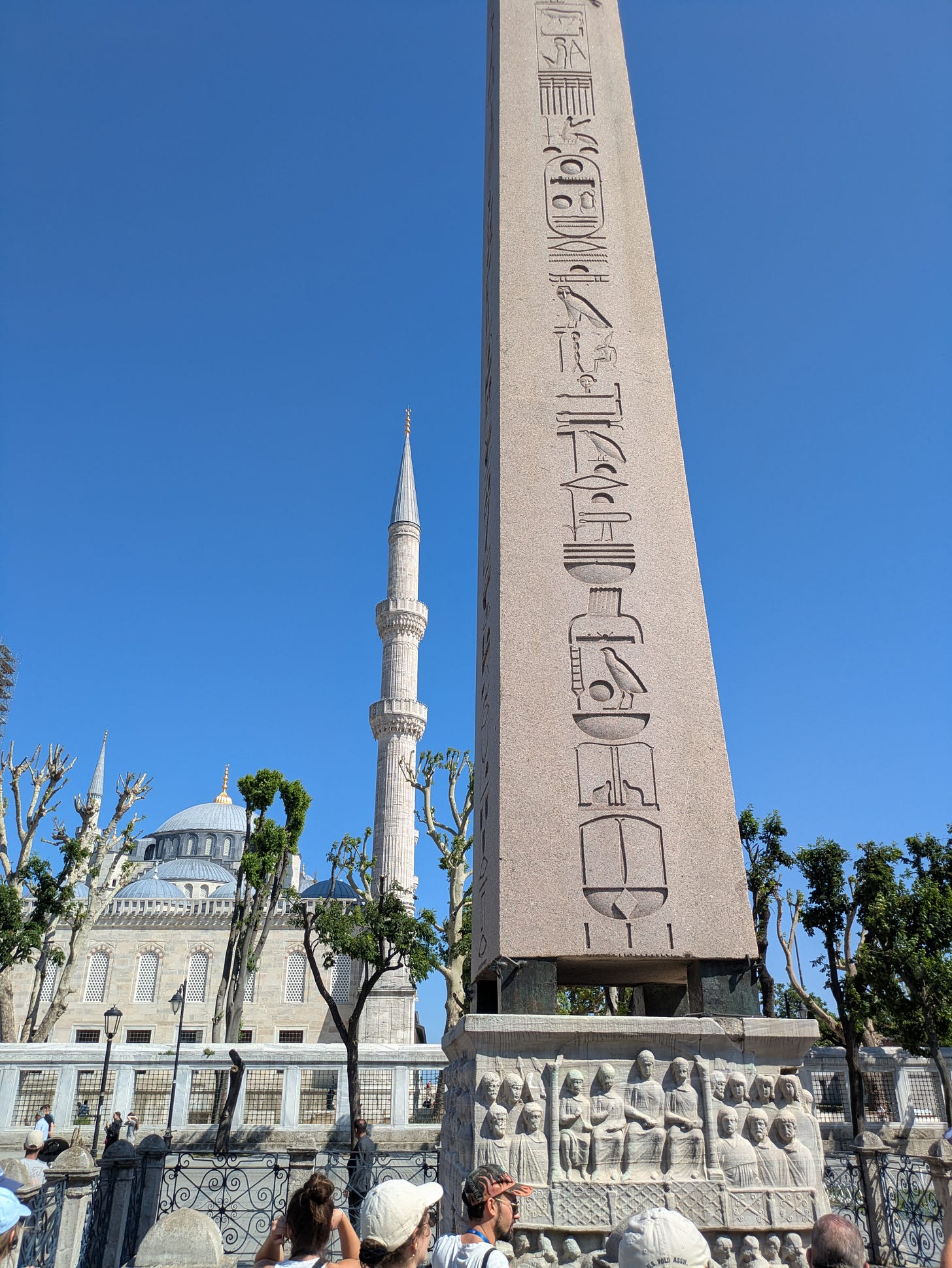
Our guide took us through the Blue Mosque, pointing out the blue tiles which were very expensive when the mosque was built in the 17th century and gave the mosque its name. The Blue Mosque was built by a young Sultan Ahmed who commissioned for 6 minarets. At the time, no mosque had more than 5 minarets except for the Great Mosque of Mecca. As such, to avoid a scandal, the young sultan had a 7th minaret built at Mecca. Our guide then took us down some quieter streets to the Sokollu Mehmed Pasha Mosque. Away from the crowds this quiet mosque includes fragments of the Hajar al-Aswad, or Black Stone, which Muslims believe was given to the Prophet Abraham by Angel Gabriel. A stroll past the remains of a platform built by the Byzantines to provide flat ground for the hippodrome, then through the Arasta Bazaar brought our tour to an end back in the square where it began.
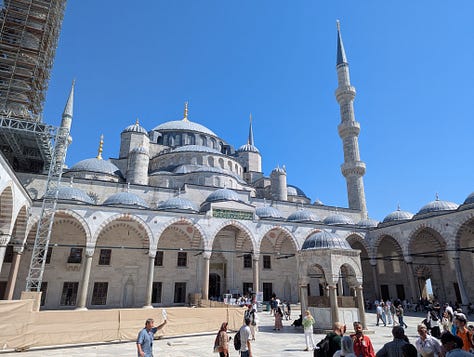
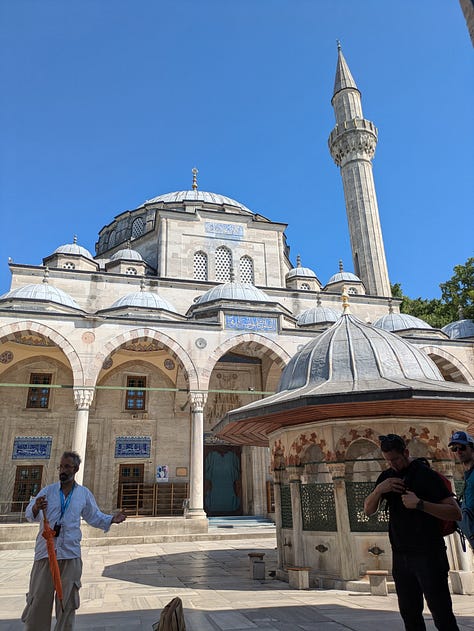
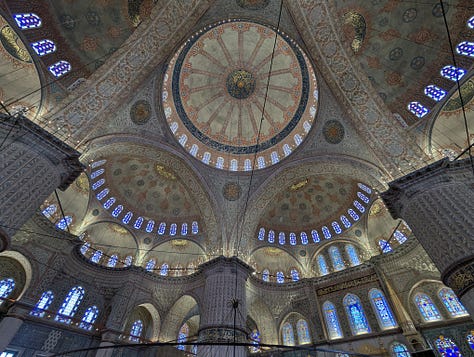

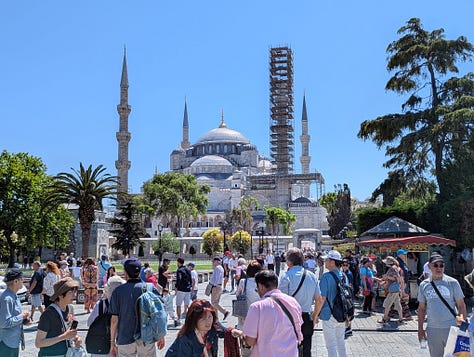
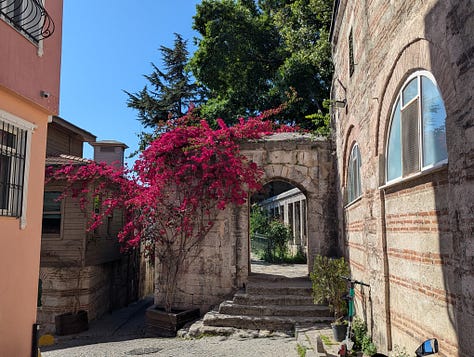
After the tour, we took our guides advice and climbed onto the rooftop of a restaurant conveniently located halfway between the Hagia Sophia and Blue Mosque. The restaurant allows tourists in the know to access a portion of their rooftop terrace free of charge to admire the view. Shortly after we arrived, the call to prayer rang out. A bit of a duet between the Hagia Sofia and the Blue Mosque ensued, which was absolutely beautiful to witness.
After this we ended up finding a place to treat ourselves to some kebab in a less touristy area at an ok price. The food was delicious and we tried Salgam, a spicy fermented carrot and turnip drink which kind of tastes like clamato juice.
6-Jun-2025: Ottoman Buildings in Balat
As Istanbul's bazaars were closed for Eid al-Adha and some other sites were on reduced (and often unpublished) hours, we decided to walk through the Balat and Fener neighborhoods. These neighborhoods are known for numerous colorful Ottoman style houses and also recent gentrification. Once Balat was a poor neighborhood, but now that the historic building have become popular, wealthier people are moving in and renovating. This process was clearly not complete as some decrepit and crumbling houses stood right beside fancy, brightly painted houses that had been restored.
We meandered through the hilly streets, taking a few photos for ourselves and chuckling at other tourists clearly posing for their latest Instagram shot. Before making our way back for a relaxing evening, we stopped for a while at a little cafe who's only other patrons were a couple of older Turkish gentlemen with a tea in one hand and a cigarette in the other. We joined in (minus the cigarettes) and sat quietly on the street side watching the world go by.
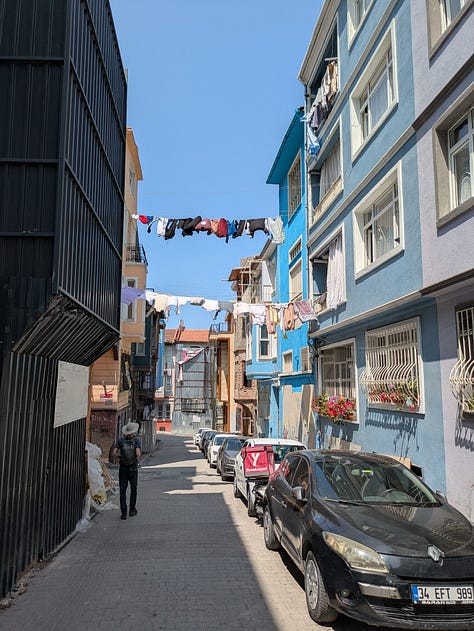
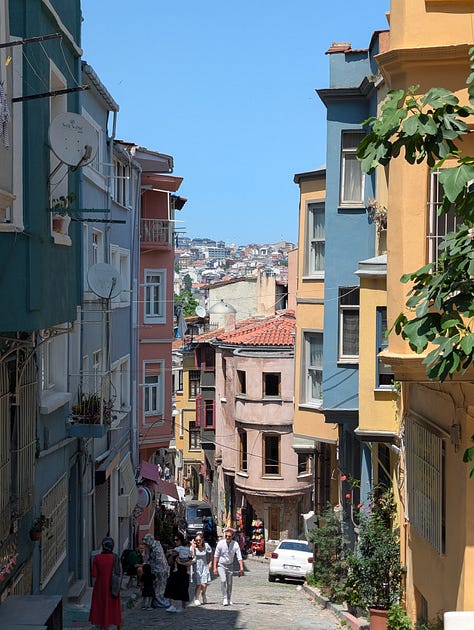
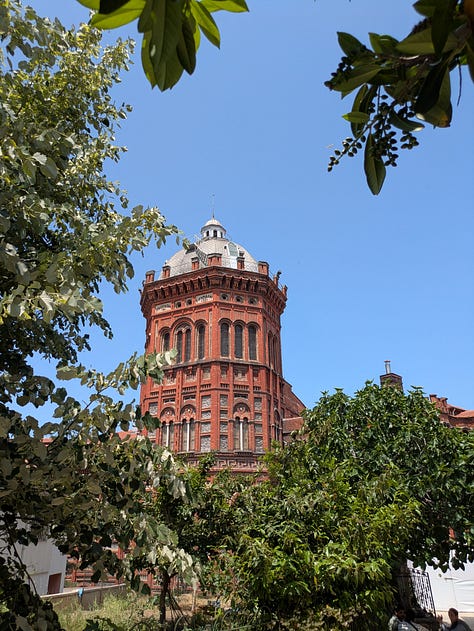
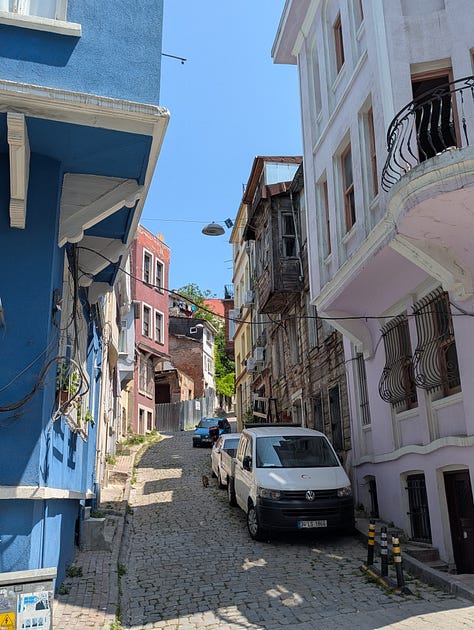
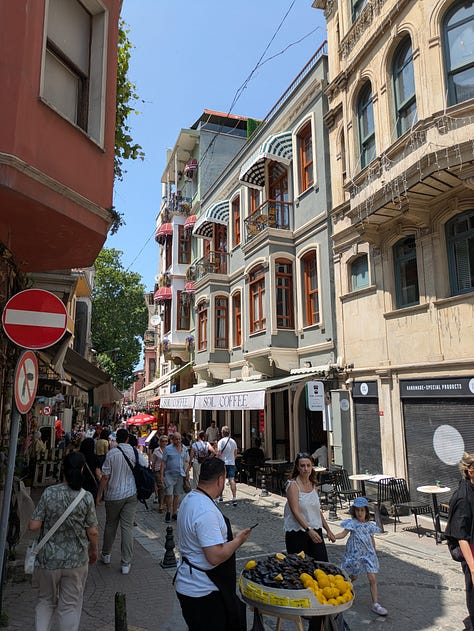
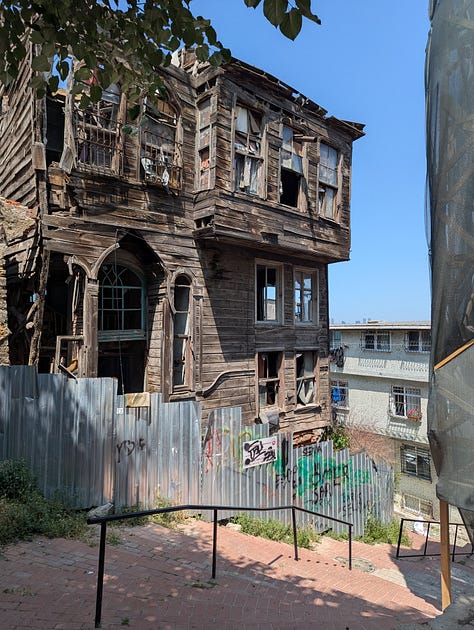
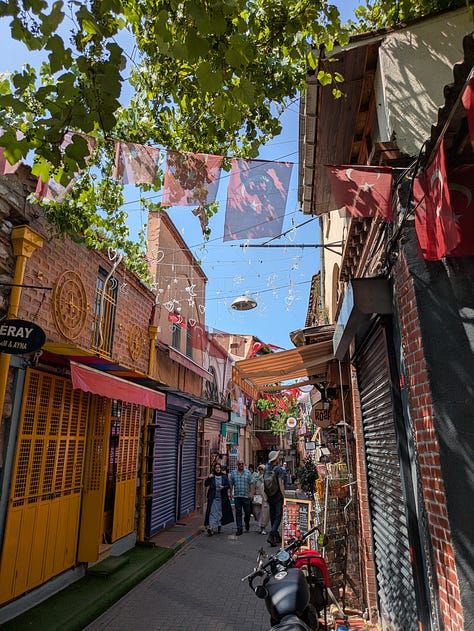

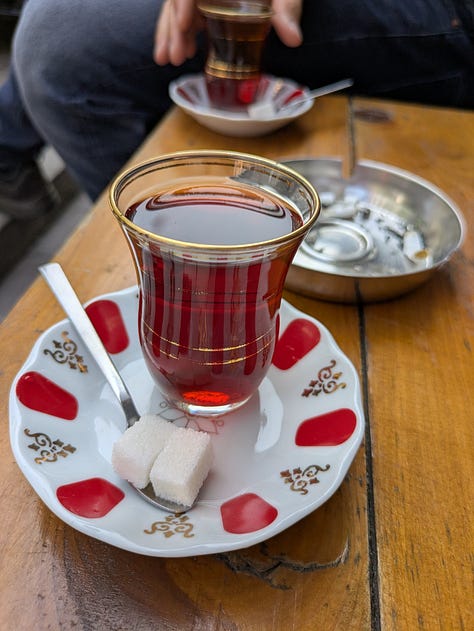
7-Jun-2025: A Local Hammam Experience
The hammam, or Turkish bath, is famous the world over and there are no shortage of options in Istanbul. Many are catered to tourists and offer a luxury experience accompanied by a luxury price tag (some we saw started at €85 per person). We found a Reddit post discussing local Hammams in Istanbul which directed us to Üsküdar Valide-i Atik Hamamı on the Asian side of the city - the Google reviews matched the discussion on Reddit so we set off.
On route we stopped by the Kuzguncuk neighborhood, another popular historic neighborhood featuring some heritages buildings and a community garden. After snapping some pictures and listening to a self guided audio tour, we enjoyed some treats from a bakery and set off for the Hammam.
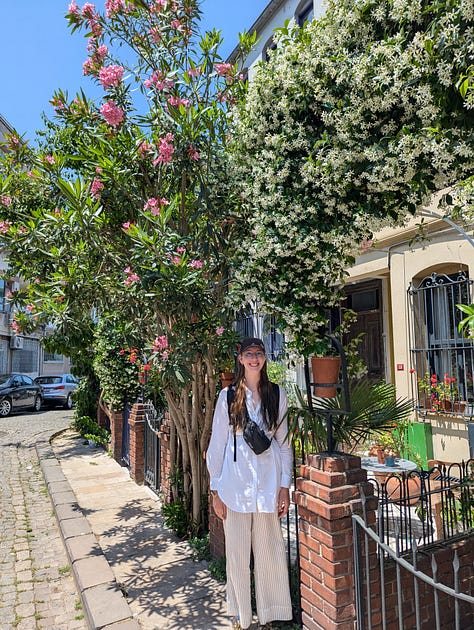

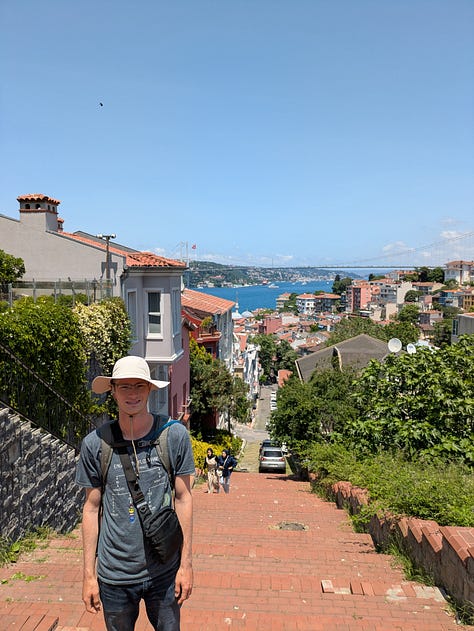
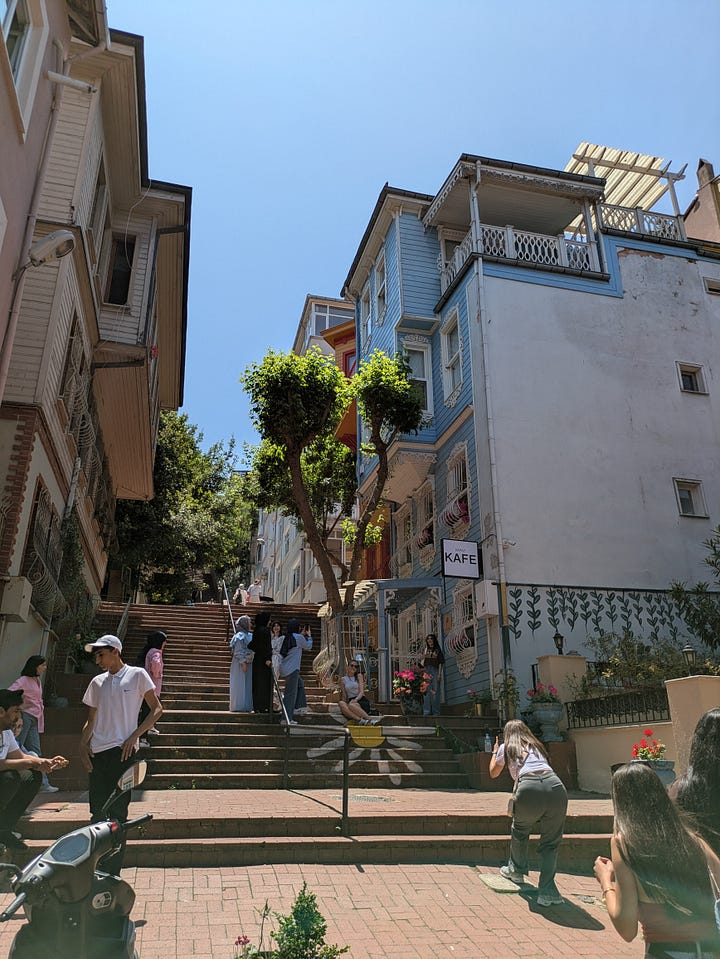
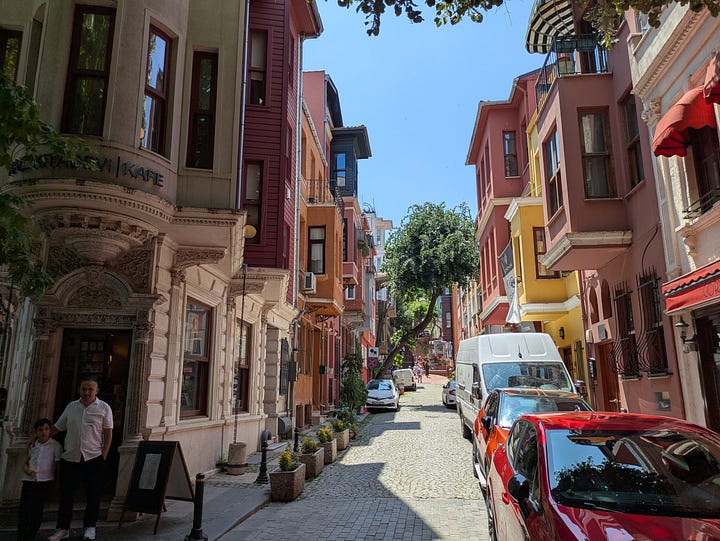
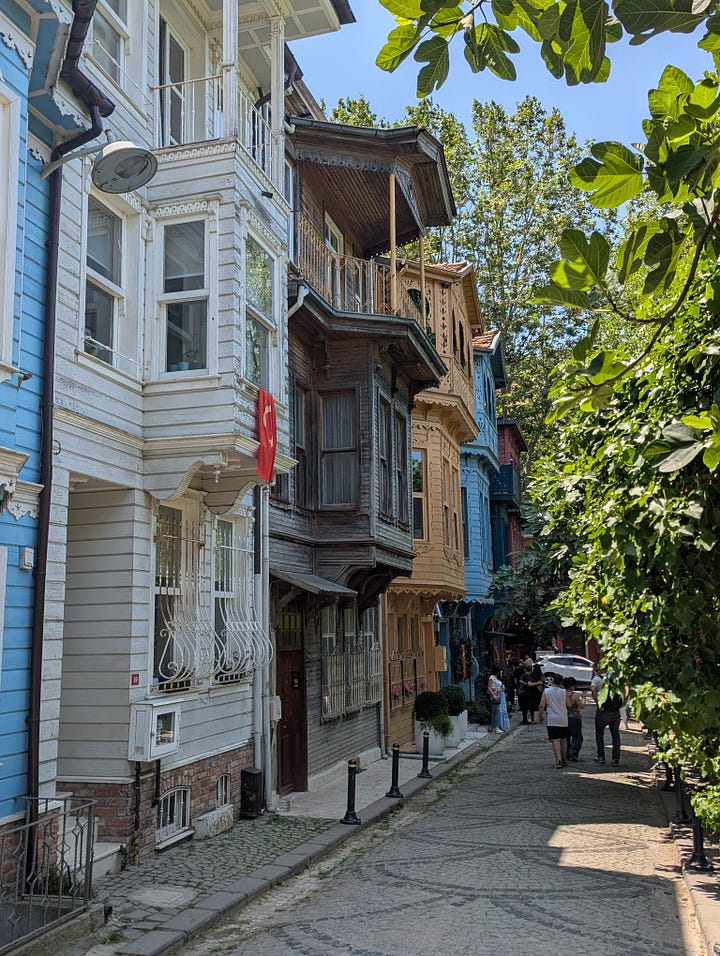
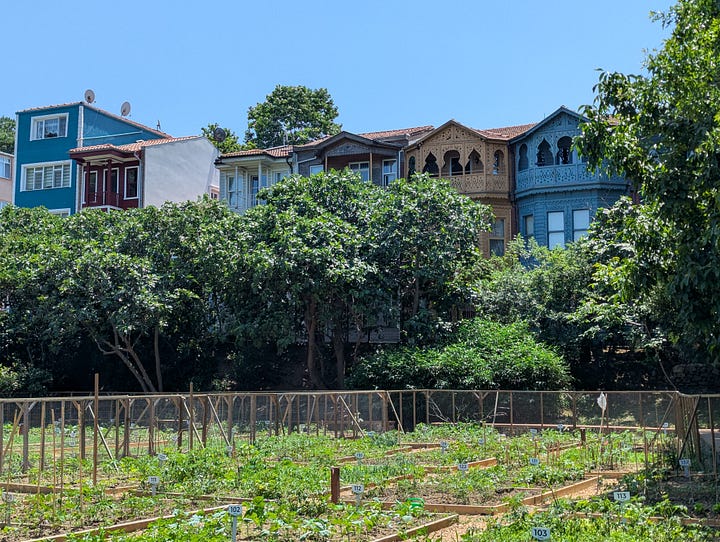
According to a plaque above the door, the Hammam was originally built in 1579 and was refurbished in 1985. As is tradition, we split up and headed to the separate entrances for men and women. Each side of the Hammam has a similar layout with a lounge area by the entrance and small lockable rooms for changing. We'd read conflicting reports about what to wear; some sources said to wear a swimsuit and others said men could go naked while women should wear bottoms at least. We went the safe route with swimsuits and started the process.
Scott got the full deal: Heat soak in the Hammam sauna which is supposed to open pores and soften the skin, exfoliation, oil massage, and soap massage/scrub. Minimum English was spoken here, so selecting the treatment required pointing at prices handwritten on a notepad and instructions during the process consisted of commands and motions to turn, sit, or lay down at the appropriate time. The burly Turkish grandpa doing the massaging and scrubbing was a bit rough; some of the massaging was a bit intense and while he was working the back of the legs it felt like kneecap damage might be a risk. Despite the intensity, Scott felt very clean and relaxed by the end. At this particular Hammam, the experience was only 700 lira (around €15) - on the men's side, Scott was the only customer so it was a private Hammam experience!
In the women's Hammam, Mary started by sitting in the hot steamy area under the dome. Quickly becoming quite hot, she sat there for a while using the available plastic pails to pour cool water from the taps over herself. There were a few other older woman around, but it wasn't clear if they were staff of the hammam or other patrons. Eventually the scrub and massage started; a Turkish lady gave Mary one word instructions in English to change position and periodically get scrubbed, rinsed and then soaped up. At this point, another patron approached Mary. She was a flight attendant with Turkish airlines; they had a nice but odd conversation while Mary was awkwardly getting scrubbed down. For some reason, the oil massage wasn't available on the women’s side of the Hammam, so the price was only 550 lira (€12).
The final result: we both left with our skin feeling softer than it has possibly ever felt. We usually have our scrub gloves to wash with, but the Turkish exfoliation glove mixed with some aggressive elbow grease and a steamy sauna environment is very effective. 10/10 experience.
8-Jun-2025: The Theodosian Walls
Theodosian Walls (or the Walls of Constantinople) are a line of fortifications built by the Byzantines in the 4th and 5th centuries. The walls stretch roughly 7km from the Golden Horn to the Sea of Marmara, securing the land facing side of ancient Constantinople (the old part of the European side of modern Istanbul).
Today, the walls are in a bit of a disappointing state. The outside of the walls largely face overgrown “parks” and a large highway runs parallel to the wall. We walked the length of the walls, north to south, mostly on the city side of the wall. Many sections here are not particularly pretty - poor rundown neighborhoods, piles of rubble, and parked cars abound. Occasional mosques provide better ambiance.
The upside is that for most of the way you walk along a road directly beside the remains of the walls. Originally up to 12m tall, the walls still tower over the street. When walking past the businesses, crumbling houses, and parked cars, one wonders if the İstanbullular appreciate the significance of the ancient walls next to their homes or shading their cars or if the omnipresence of the fortification has become so routine as to escape notice. The walls made Constantinople nearly impenetrable for a thousand years - only being breached twice, first by the crusaders in 1204 during the fourth crusade and second in 1453 when the Ottomans conquered the city.
Our walk was largely uneventful. We passed one museum in a former Byzantine palace, but elected not to visit as it didn't seem overly exciting. All along the walls we passed ancient stairs which once provided access to the battlements at the top of the wall. We had read that, in the not so distant past, it used to be possible for the daring to climb these stairs to walk along the top of the walls. Today this is not possible; locked gates, often covered with corrugated steel and topped with razor wire, block access. In some ways this is unfortunate - one of the few free historical attractions in the city has lost some excitement - but at the same time it is probably necessary to preserve the structure.
Further south, restoration and regeneration works are in progress along the wall. Manicured parks, playgrounds, and picnic areas line the city side of the wall. The structure itself seems to be in much better condition here. The price of this attention is literal: a paywall to see the old walls. In the best preserved sections, where multiple courses of wall remain, gates reserve access to paying guests. For some reason (perhaps the Eid al-Adha holiday, although most other tourist sites were open), the gates were closed and booths unmanned. Perhaps this area is still a work in progress, but we suspect when open the prices will be extortionate (at least for tourists) as is the case for many sites in Istanbul.
Our walk ended at the Yedikule Fortress, the site of the ceremonial “Golden Gate” entrance to the Byzantine city, and one final stretch of wall leading to a large road along the Sea of Marmara. From here, we caught a local train back into the centre of the old town, purchased our train tickets for the next stage of our adventure, and made our way to another of the rare free attractions in the city.
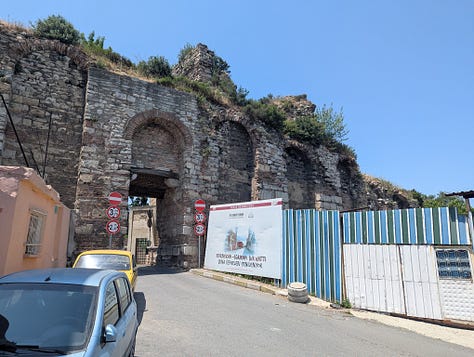
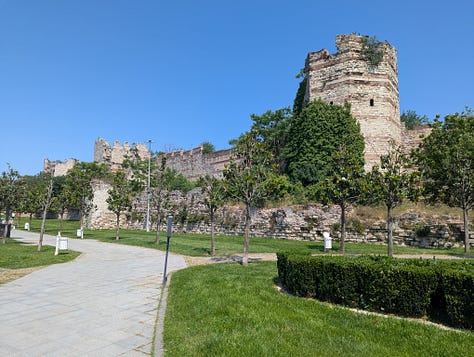

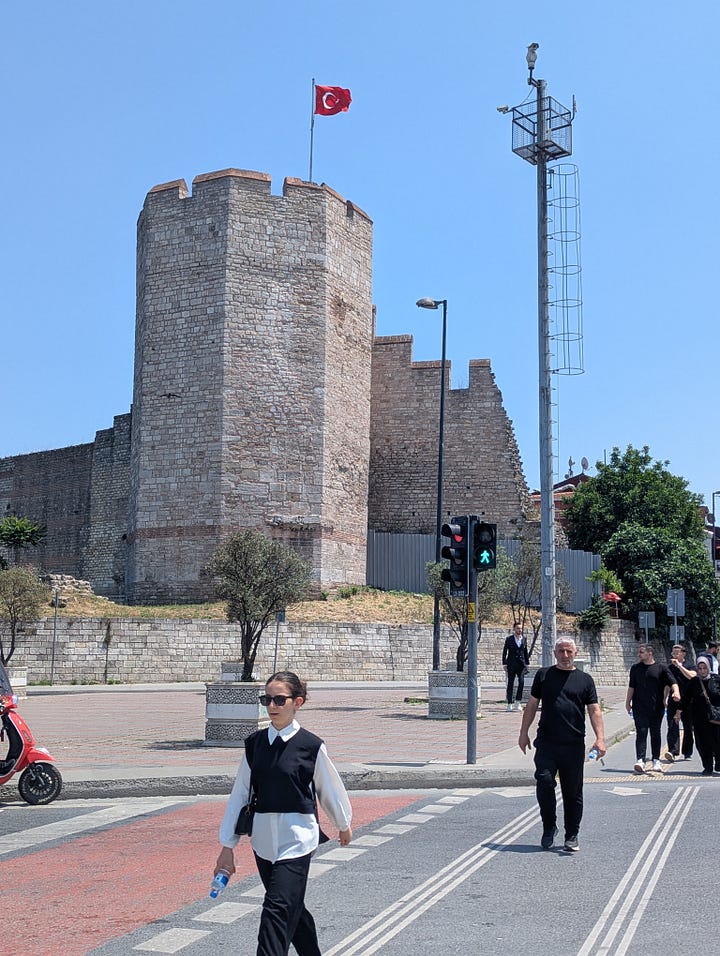
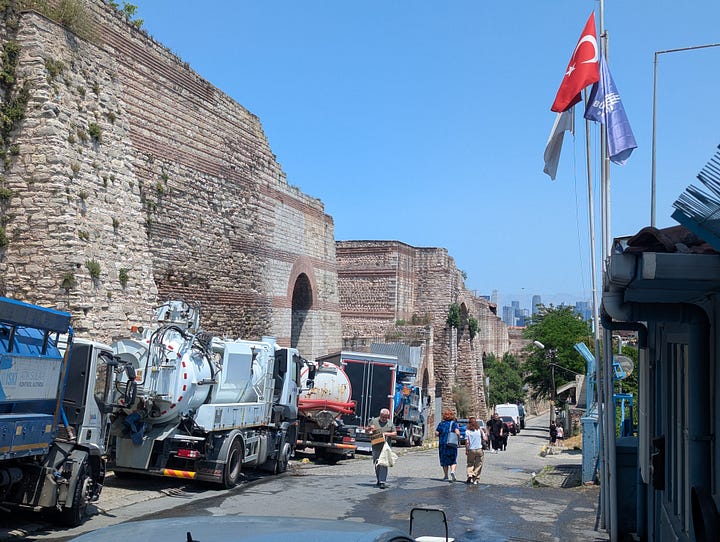
The Cistern Gallery is much smaller than the famous Basilica Cistern nearby but is free to enter. The Byzantine cistern is under a building housing an expensive carpet shop and isn't particularly well advertised. After descending stairs in the corner of the lobby, we found ourselves in the cavernous cistern. During our visit, a display from a digital reconstruction of the hippodrome explained the history of the horse racing arena that once stood nearby. Unfortunately there wasn't much information about the 6th century water reservoir in which we stood, but it was still an interesting visit and the subterranean space provided a welcome escape from the Turkish heat after our walk along the walls.
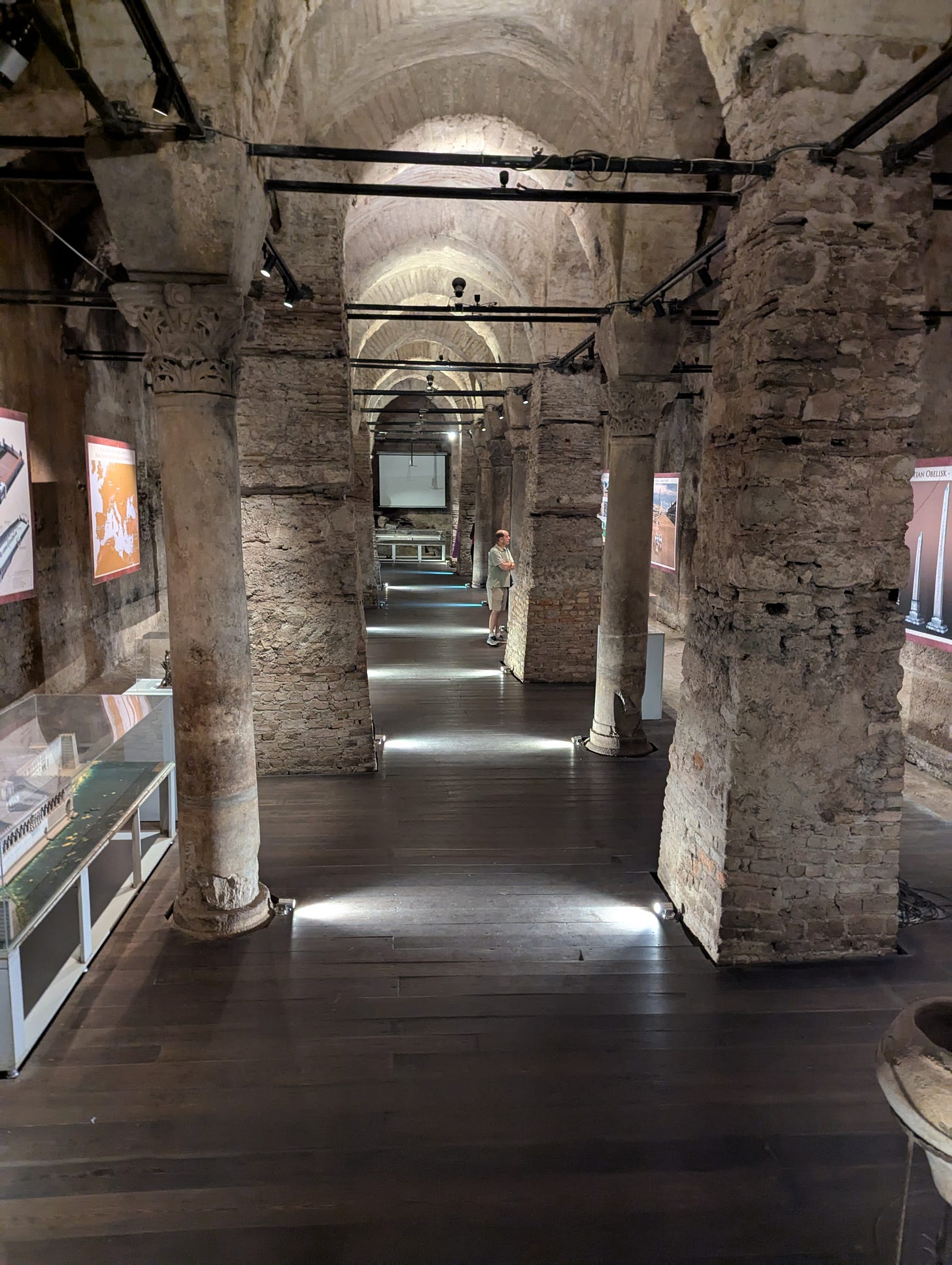
9-Jun-2025: The Princes’ Islands
In hopes of finding a slightly quieter site without straying too far out of the city, we caught the 10am a ferry from Kabatas to Adalar, a town on the Princes' Islands just off the coast of Istanbul. Prices are very reasonable as this is part of Istanbul’s public transportation network. The return journey was 178 lira, or about €4, per person at time of writing.
The ferry terminal was carnage, possibly made more extreme on the last day of the four day Eid al-Adha holiday. Turks don't seem to acknowledge the concept of a queue - a bit of an affront to the British love affair with queueing we had become accustomed to in the UK. Nearly half an hour before departure time, a crush of people had accumulated on the pier with a considerable amount of jockeying for position. Someone must have announced which vessel to board and opened a barrier, then all hell broke loose with people running in the direction of the ferry. We weren't in a rush or bothered to get a particular seat, so we sauntered with the less manic portion of the crowd and found seats on the middle aisle of the ferry.
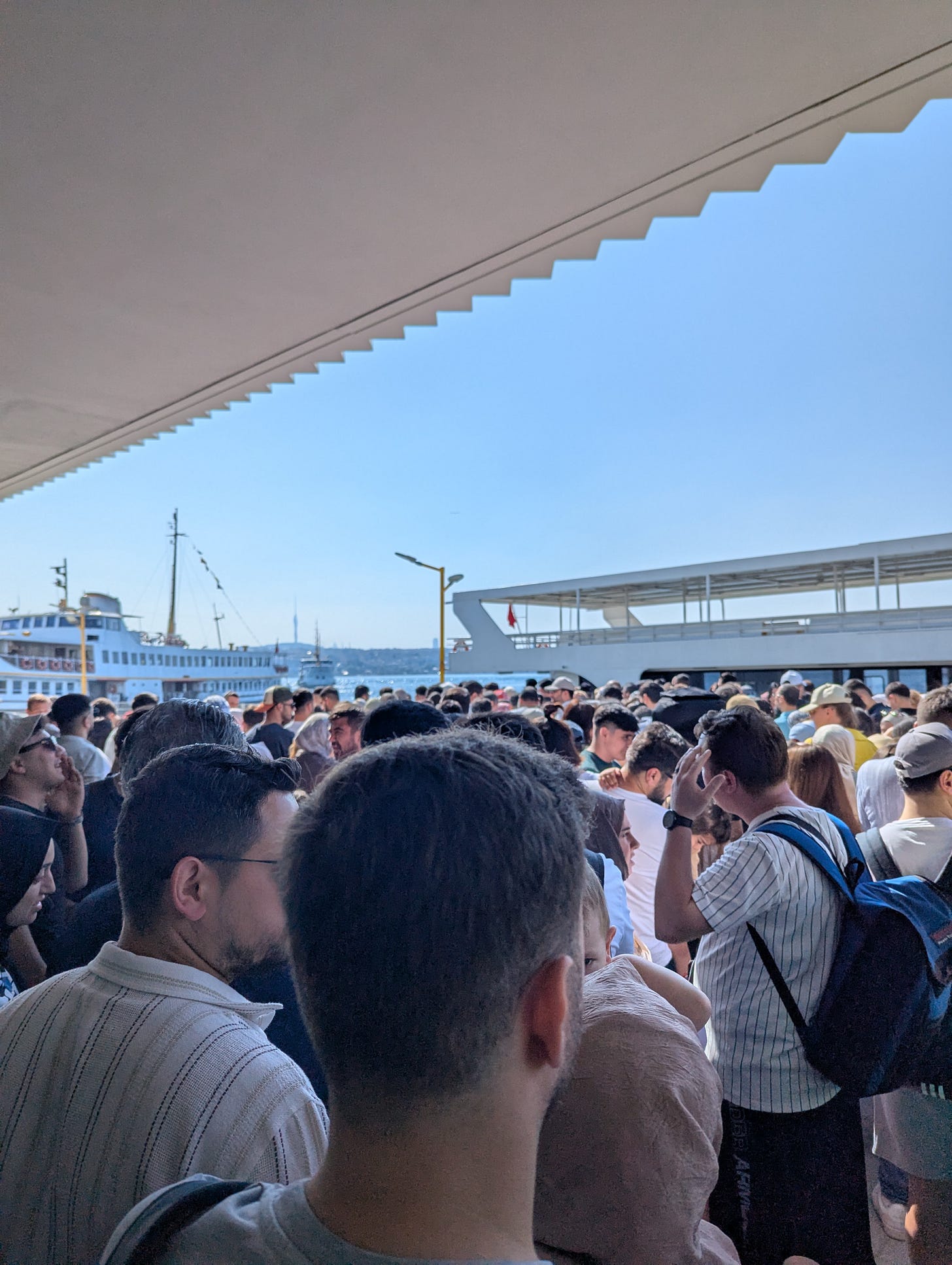
The journey was rather crowded, but not uncomfortably so. Most seats were occupied and late arrivals sat on the floor or stairs. A cafe on the middle deck had reasonable prices (15 lira for tea and coffee from 80) and a constant queue we didn't feel like waiting in - apparently after the initial pandemonium, some order had returned. Throughout the journey, vendors with trays piled high with simit roamed with bellows of “SIMIT! SIMIT! SIMIT!” advertising the sesame encrusted bread rings available with Nutella or cheese spread.
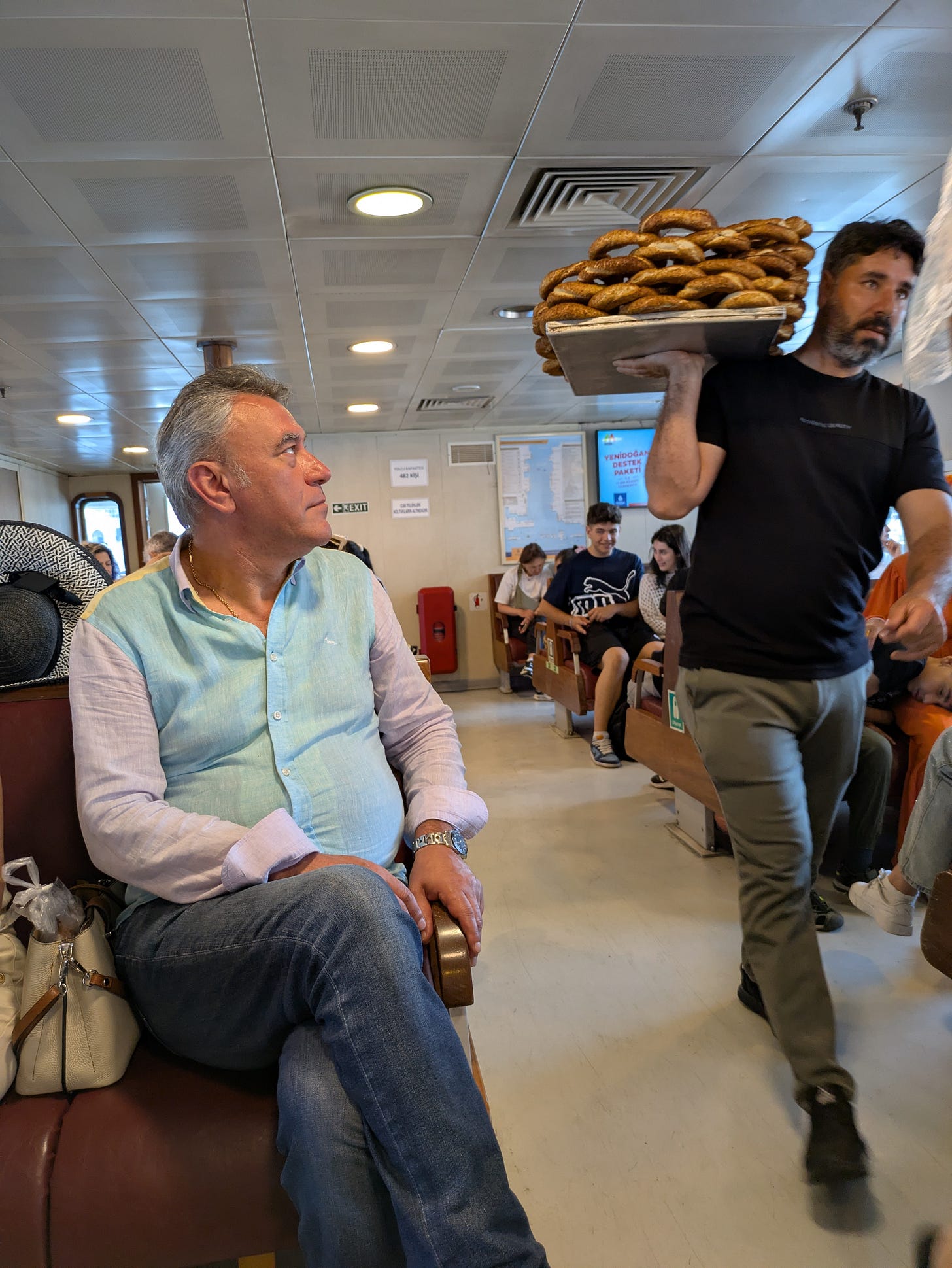
We spent the day wandering the island. No cars are allowed on the Princes’ Islands and we were on Büyükada, the largest in the archipelago. We walked along the road encircling the island. Once outside of Adalar, the island's town, it was much quieter. There were a steady stream of people on rented bicycles and the occasional small electric island shuttle bus, but compared to the heart of Istanbul it was pleasantly quiet.
After about 4km, we came across a cafe with a terrace overlooking the sea. We decided to sit a while and have a tea - or çay as it's called in Turkey. Although 35 lira per cup was over double what we had payed in Balat, the equivalent of €1.57 for the two of us didn't seem too unreasonable.
We continued along the road until it was met by a dirt path heading uphill. We followed the path, aiming for a monastery near the island's highest point. With the exception of a gaggle of teenagers, we had the path to ourselves until we neared the monastery and joined the more popular paved road up the hill.
A sign explained that the Greek Orthodox monastery was first founded in the 10th century before being destroyed by either crusaders during the fourth crusade (13th century) or pirates (14th century). A fourth century icon of St. George which had attracted pilgrims to the monastery disappeared with it's destruction, however, in the 18th century, the icon was allegedly found by a sheppard and the monastery was reestablished. Today, the monastery church is a popular pilgrim site for both Christians and Muslims. On April 23, the feast day of St. George, people of both faiths climb the hill to pray and receive a blessing from one of the monks in a curious interfaith event.
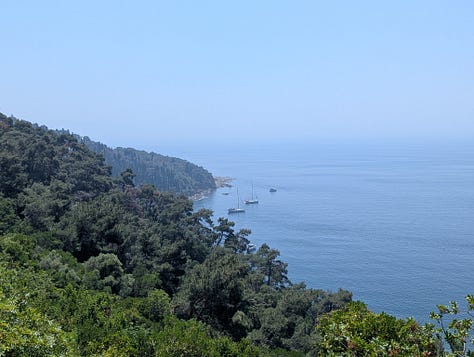
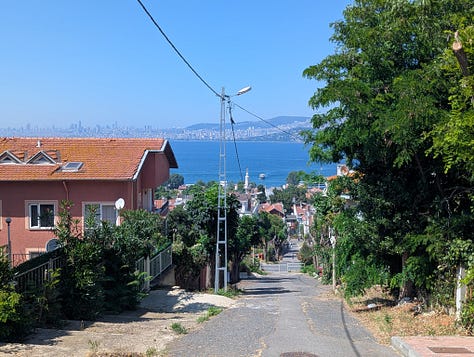
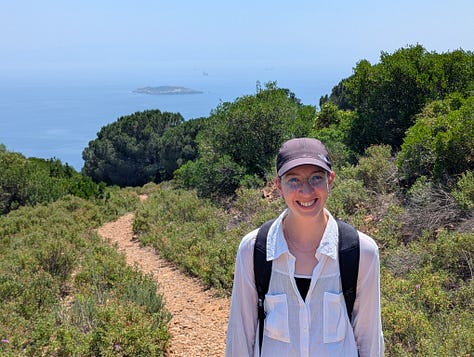
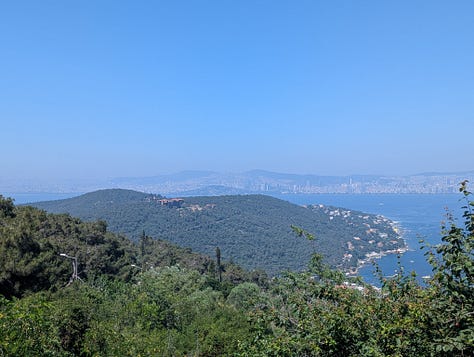
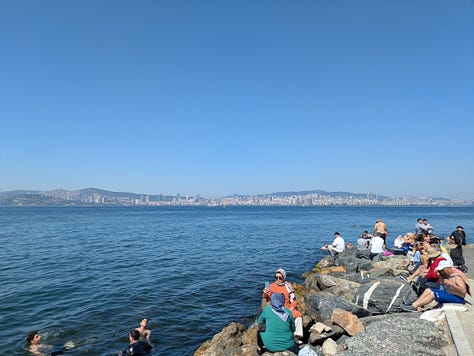
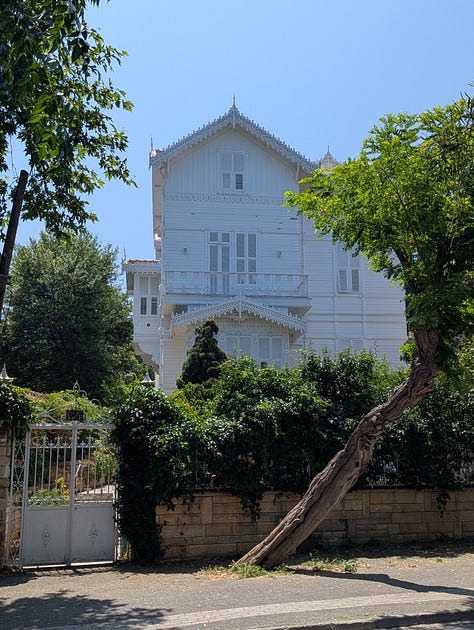
On our way back to the town, we passed the Büyükada Greek Orphanage. The building is currently abandoned and in a rather poor state, but around the turn of the 20th century it was built to be a grand hotel and casino for travellers on Oriental Express. The Ottoman sultan refused to give the casino a permit for operation, so the 20,000 square meter wooden building (apparently the largest wooden building in Europe and second largest in the world) was sold to the wife of a Greek banker, donated to the Ecumenical Patriarchate of Constantinople, and run as an Orphanage until 1964. At this point, the Turkish state forced the closure of the orphanage during a period of conflict with ethnic Greeks centred around Cypress. In 1994, the building was seized by the Turkish state. In the decades since the orphanage’s closure, the building has been allowed to deteriorate significantly and it is now in very poor condition. After a long legal dispute in both Turkish courts and the European Court of Human Rights, the building was returned to Ecumenical Patriarchate in 2012. There are apparently plans to restore the building and turn it into an environment centre of some description, however there were no signs of progress in what would certainly be a multimillion euro project when we visited.
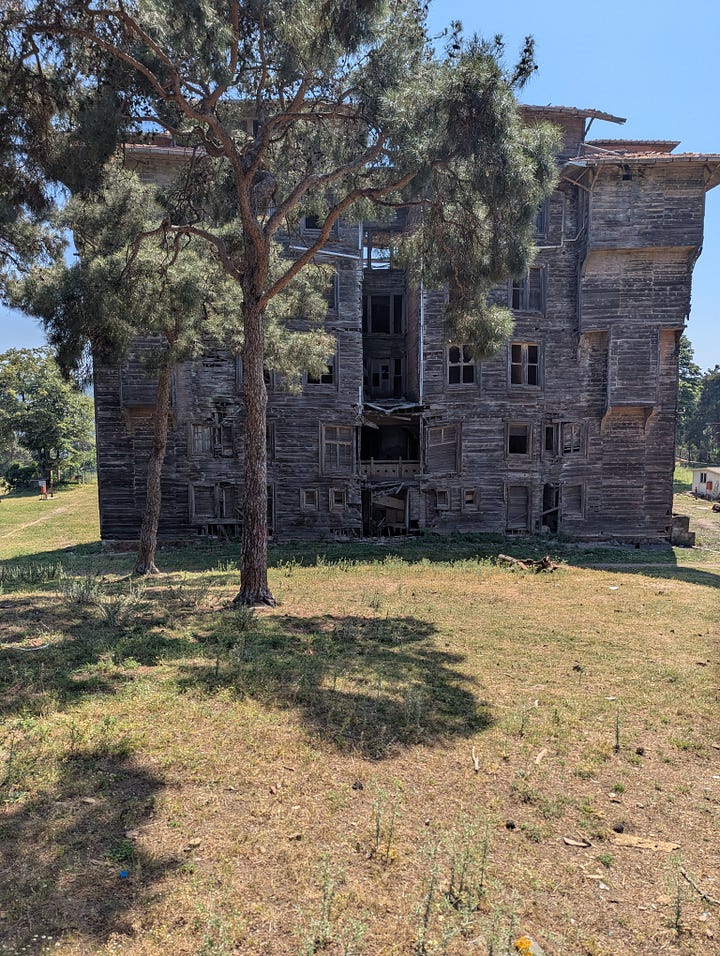
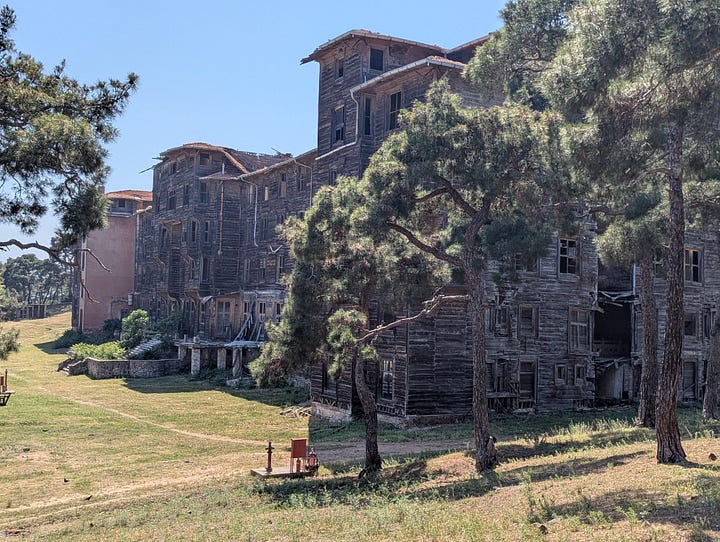
Our return ferry to Istanbul was slightly less hectic than outward journey. Although we seemed to get on a departure which wasn't on the schedule. A attendant at the gate said it went to our desired port, so we hopped on and hoped for the best. The journey was quicker than expected as we didn't stop at all the other islands - we were back in Istanbul in little over an hour.
10-Jun-2025: Browsing Bazaars
With the Eid al-Adha holiday over, Istanbul's famous Bazaars were back open, so we took a stroll to check them our. Our first stop was the Spice (or Egyptian) Bazaar. Two covered isles are lined with vendors selling all sorts of spices, teas, Turkish delight, and other souvenir type objects. As we made our way through, we took advantage of the samples on offer to entice potential customers (mostly tourists) into a shop.

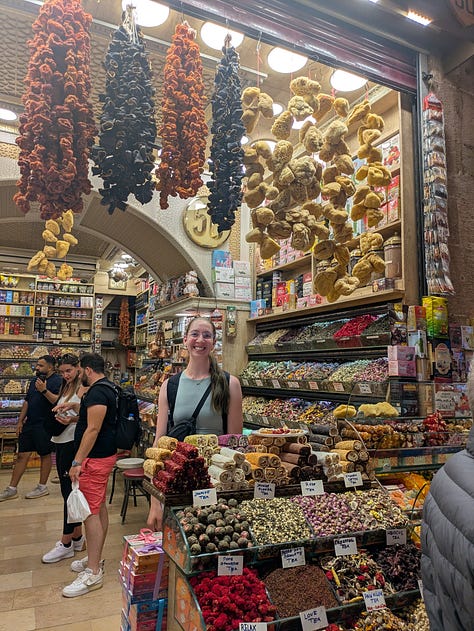
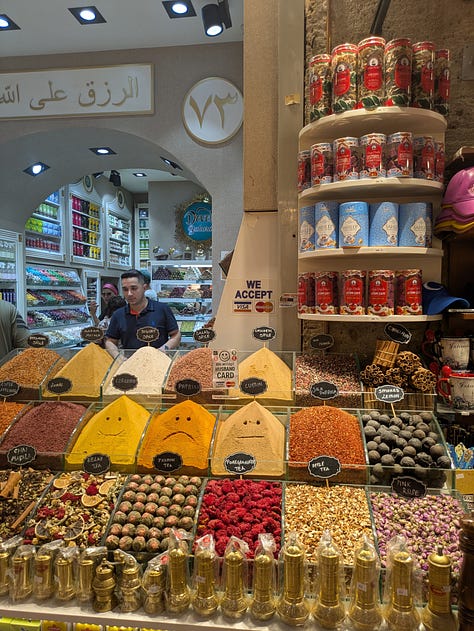
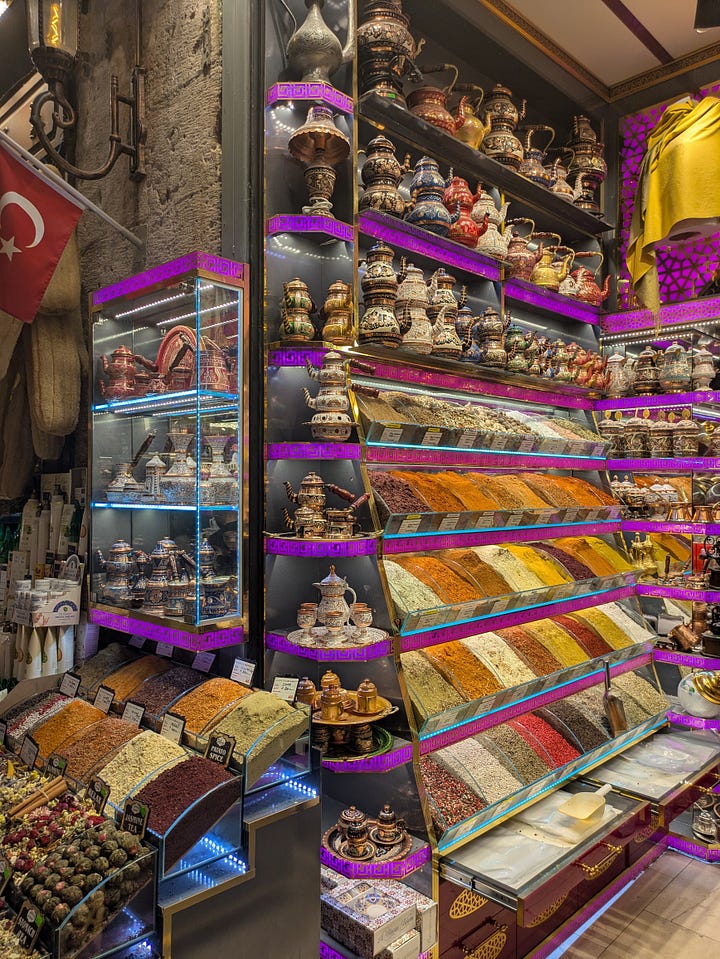

After the Spice Bazaar, we made our way to the Grand Bazaar. The Grand Bazaar is a building filled with a massive grid of small shops selling pretty much anything you can imagine - shoes, cloths, jewelry, carpets, souvenirs, etc.. We wandered through for a while until Scott had enough of shopping without any intention to buy anything. Mary continued to browse a while longer while Scott went for a more relaxed visit to the Suleymaniye Mosque to check out the grave of Sultan Suleiman the Magnificent and enjoy the mosque’s gardens.
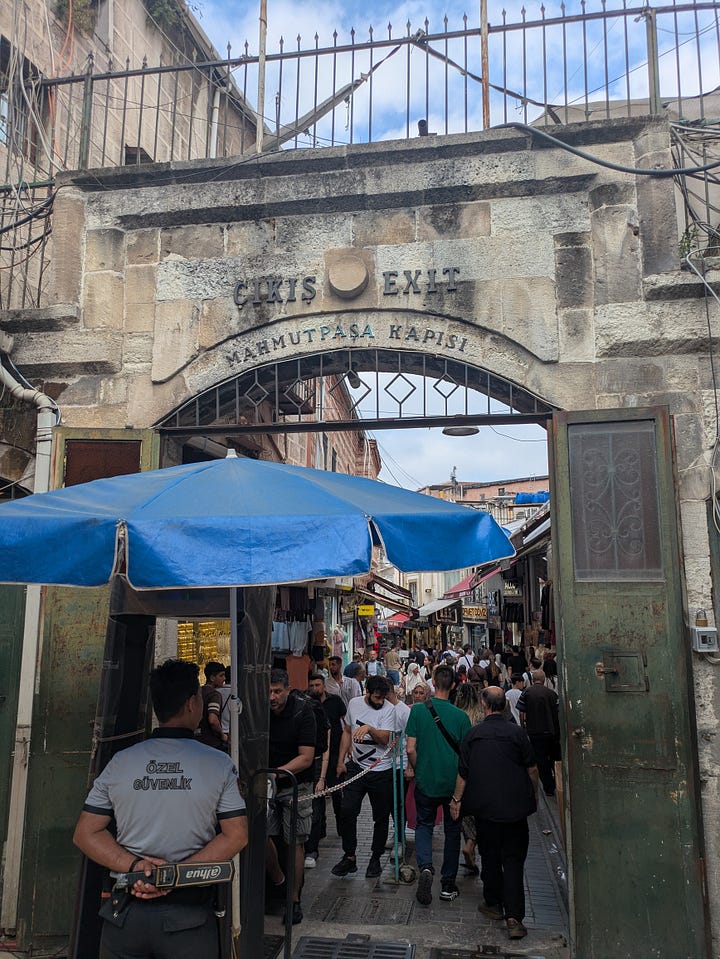
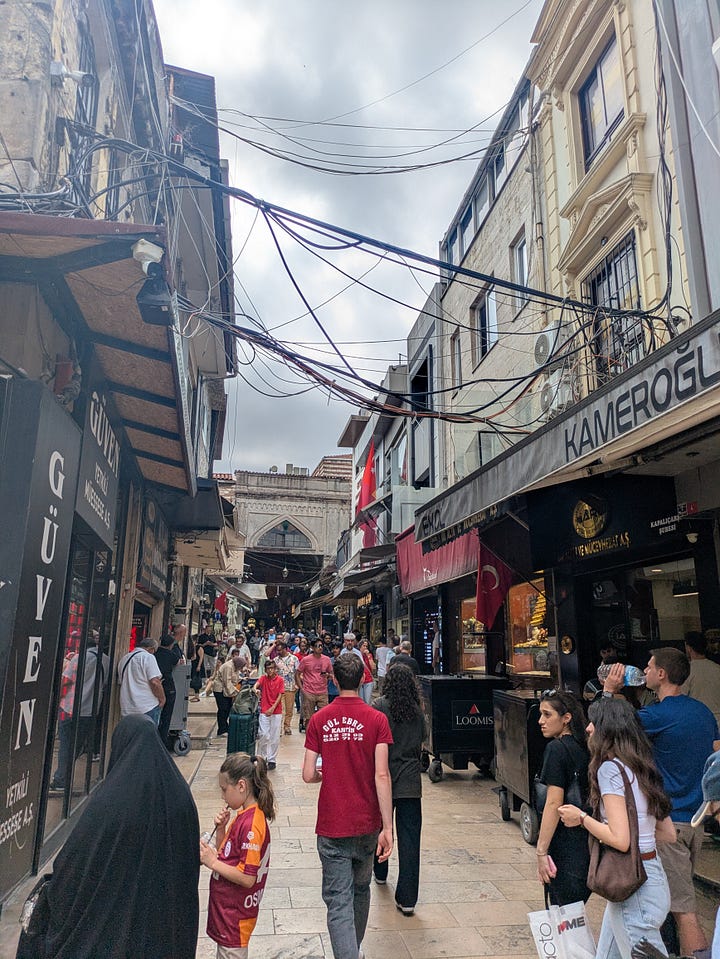
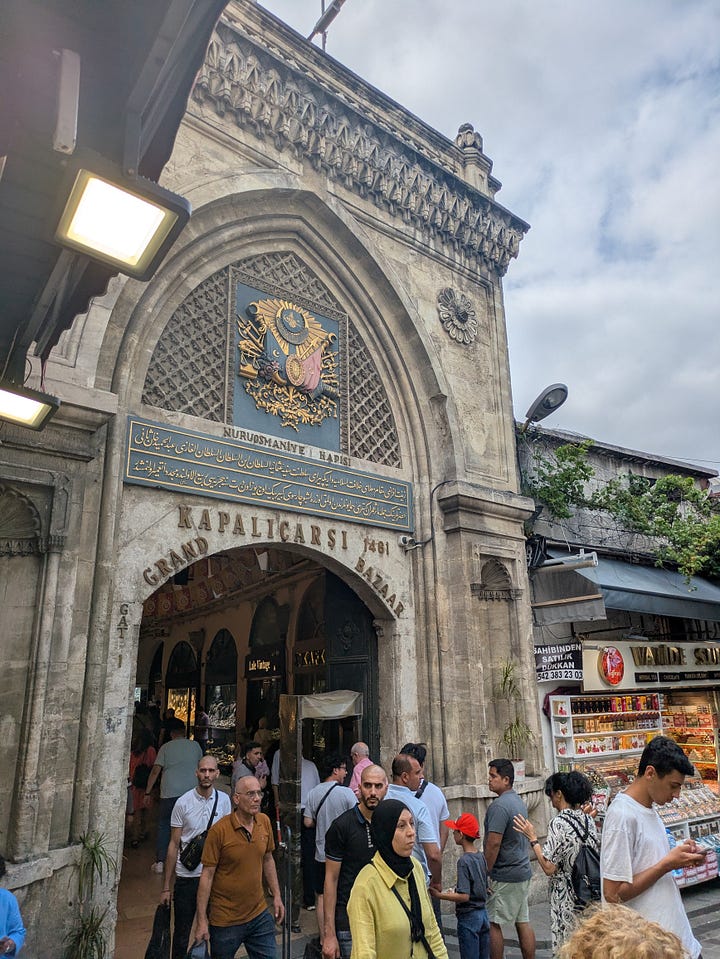
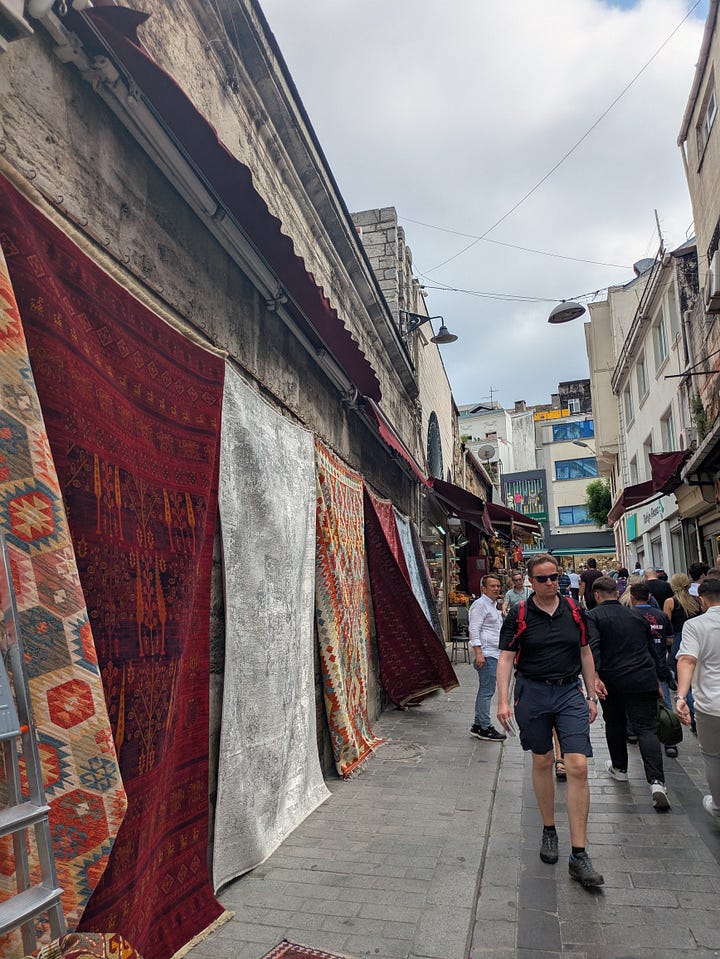
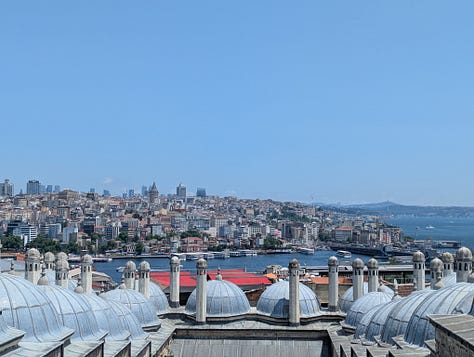
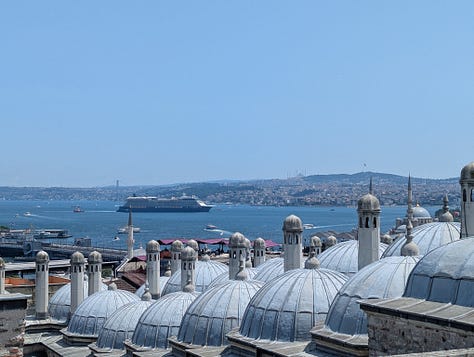
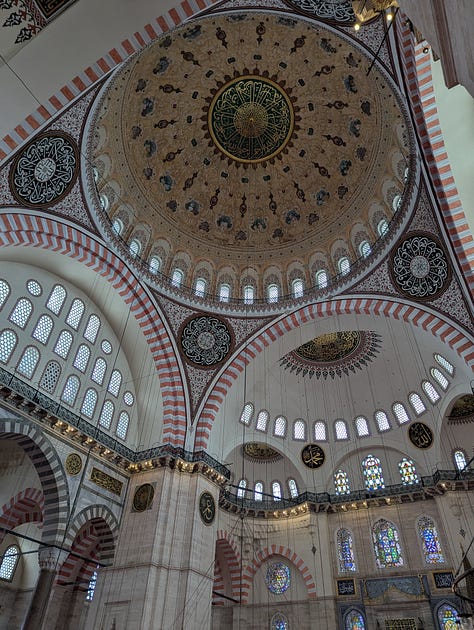
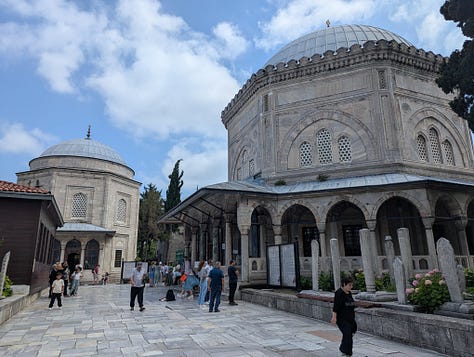
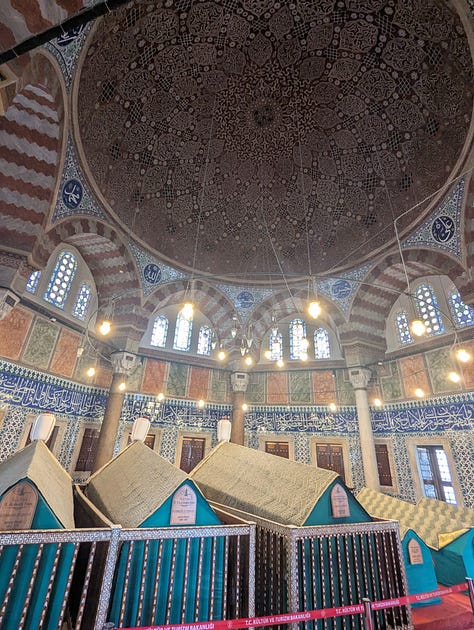
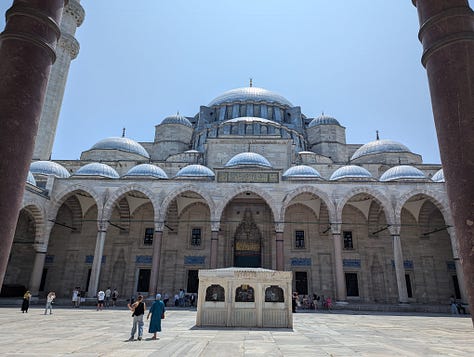
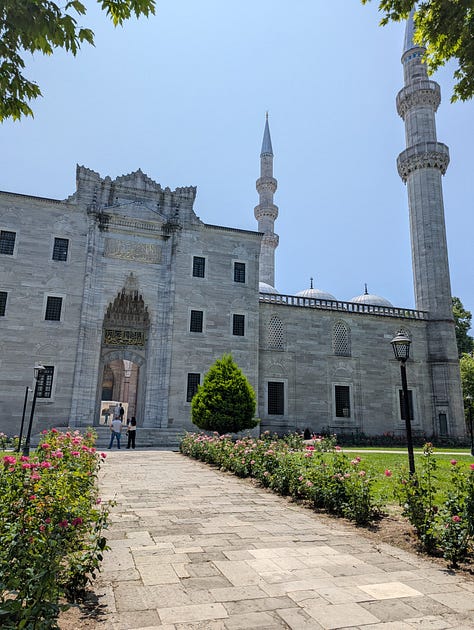
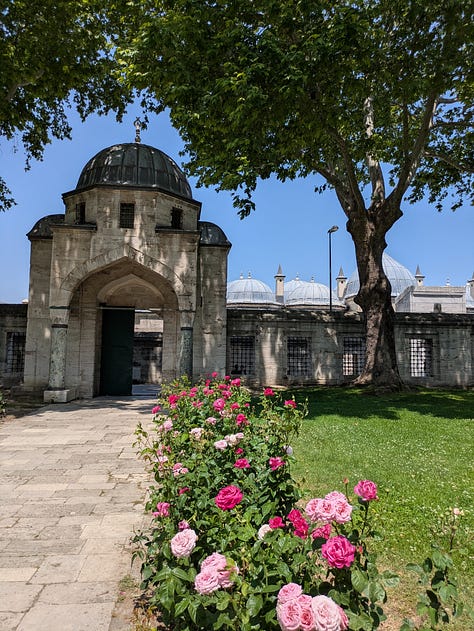
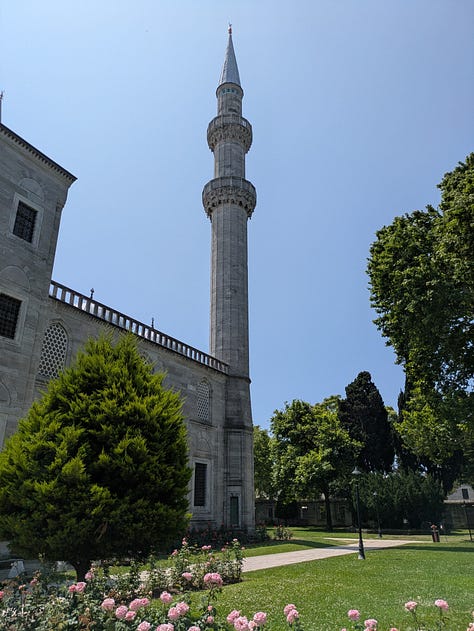
After an hour or so, we regrouped at the Turkey İş Bank Museum. The former home of the Istanbul branch of Turkey's National bank, the museum explains the role of Turkey İş Bank in building both Turkey's banking industry and a number of sectors of the economy. This was viewed an an important part of guaranteeing Turkey's independence after the creation of the modern state in 1923. Although the museum was relatively small and almost everything required Google translate to read the Turkish information panels, admission was free and it was an interesting visit!
11-Jun-2025: Ferries and Forests
On our last full day in Istanbul, we decided to take a cruise along the Bosphorus using public ferries. We had seen “Bosphorus Tours” advertised in various places, one boat had a sign saying it cost 250 lira per person. Public transportation would be cheaper and give us the option to get off and wander around - each stretch on the ferry costs only about 45 lira (€1) per person.
We took the ferry from Beşiktaş up to the Sariyer District, not far from the Black Sea end of the straight. Along the way, we passed waterside mosques, Rumeli Fortress (an Ottoman castle which is currently being restored), and increasingly lavish waterside villas - Google maps said some of these were summer residences for various ambassadors to Turkey.
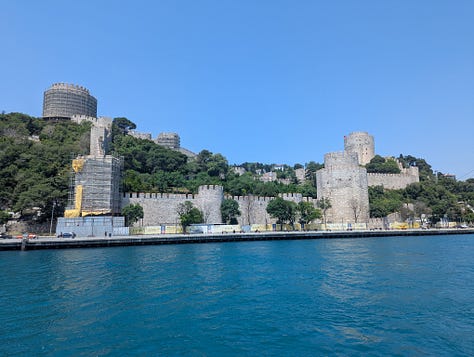
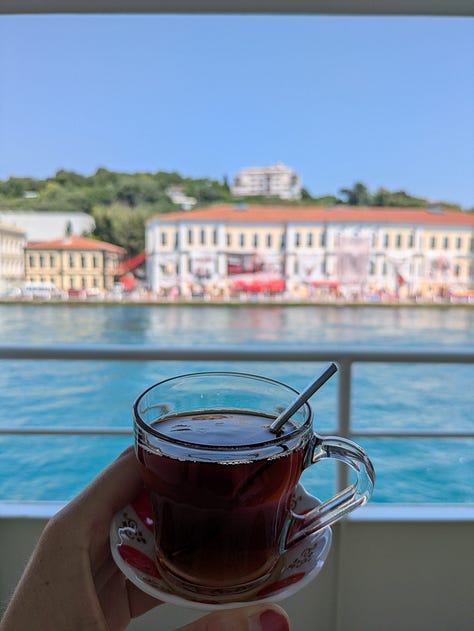
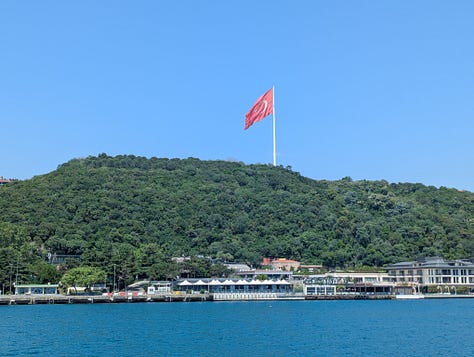

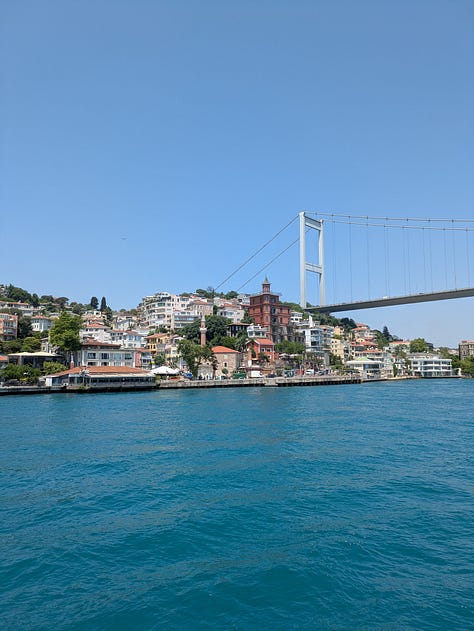

There didn't seem to be much going on in Sariyer, so we caught a bus inland to Ataturk Arboretum for a walk in the woods. The Arboretum is managed by the department of forestry at Istanbul University. We didn't find it to be particularly spectacular and information was very limited. We did however enjoy our stroll and a brief reprieve from the bustle of the city.
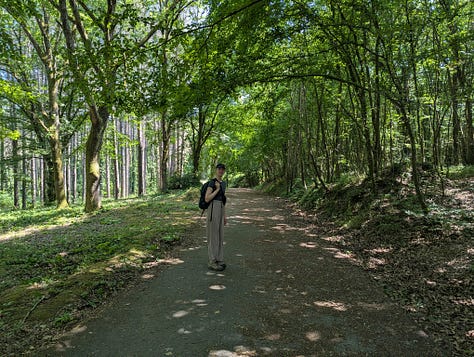
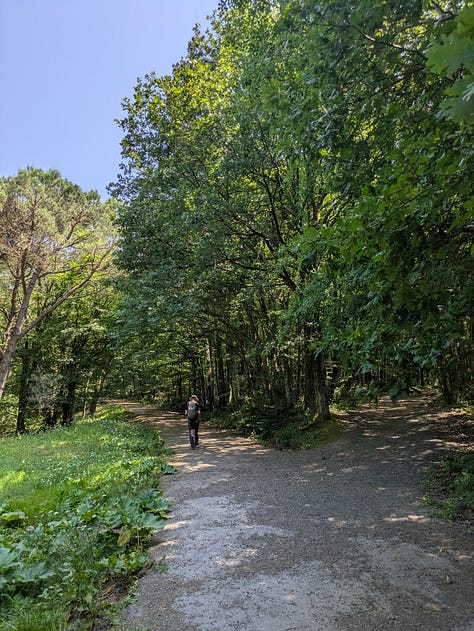

From the arboretum, we caught a bus back to the Bosphorus. We walk through posh neighborhoods, stopped for some beer (at what seemed to be a somewhat expensive craft beer bar), then caught a ferry back to the old town.
Travel Stats
The 570km train journey from Sofia to Istanbul took something like 15 hours (including a long stop at the Turkish border. We spent a fair amount of time on busses, ferries, and trams in Istanbul, but didn't keep track of this. Using the “Istanbul Kart” for public transport, we spent about 750 lira each in fares plus 180 lira to get the card in the first place - somewhere around €20 for the week, so not too bad
Over our week in Istanbul, we walked 114km or about 16.3km/day. This takes our 156 day total to 2170km!
To Be Continued…
We'll be staying in Turkey but leaving the metropolis of Istanbul. Our overland travel will continue, tune in next time to see where we end up!

